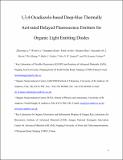1,3,4-oxadiazole-based deep-blue thermally activated delayed fluorescence emitters for organic light emitting diodes
View/
Date
10/10/2019Author
Grant ID
EP/P010482/1
EP/J01771X/1
EP/R035164/1
EP/P010482/1
Metadata
Show full item recordAbstract
A series of four 1,3,4-oxadiazole-based thermally activated delayed fluorescence (TADF) derivatives are reported as emitters for organic light emitting diodes (OLEDs). As a function of the nature of the substituent on the weak 1,3,4-oxadiazole acceptor their emission color could be tuned from green-blue to blue. The highly twisted conformation between carbazoles and oxadiazoles results in effective separation of the HOMO and the LUMO resulting in a small singlet-triplet splitting. The corresponding singlet-triplet energy gaps (∆EST) range from 0.22 to 0.28 eV resulting in an efficient reverse intersystem crossing (RISC) process and moderate to high photoluminescence quantum yields (ΦPL), ranging from 35 to 70% in a DPEPO matrix. Organic light-emitting diodes (OLEDs) based on i-2CzdOXD4CF3Ph achieve maximum external quantum efficiency (EQEmax) of up to 12.3% with a sky-blue emission at CIE of (0.18, 0.28) while the device based on i-2CzdOXDMe shows blue emission at CIE of (0.17, 0.17) with a maximum EQE of 11.8%.
Citation
Li , Z , Li , W , Keum , C , Archer , E , Zhao , B , Slawin , A M Z , Huang , W , Gather , M C , Samuel , I D W & Zysman-Colman , E 2019 , ' 1,3,4-oxadiazole-based deep-blue thermally activated delayed fluorescence emitters for organic light emitting diodes ' , Journal of Physical Chemistry , vol. 123 , no. 40 , pp. 24772-24785 . https://doi.org/10.1021/acs.jpcc.9b08479
Publication
Journal of Physical Chemistry
Status
Peer reviewed
ISSN
0022-3654Type
Journal article
Description
We are grateful to the EPSRC for financial support (grants EP/P010482/1, EP/J01771X, EP/J00916 and EP/R035164/1). We gratefully acknowledge funding through the EPSRC NSF- CBET lead agency agreement (EP/R010595/1, 1706207) and a Leverhulme Trust Research Grant (RPG-2017-231). We thank the EPSRC UK National Mass Spectrometry Facility at Swansea University for analytical services. Z.L. and W. L. thank the China Scholarship Council (grant numbers 201703780004 and 201708060003)Collections
Items in the St Andrews Research Repository are protected by copyright, with all rights reserved, unless otherwise indicated.

